Best Migratory Standing Desks
- Must Read
Like most reviews sites, our editorial staff and laboratory testing expenses are partially offset by earning small commissions (at no cost to you) when you purchase something through those links. Learn More

Just What Is Meant By A ‘Migratory’ Standing Desk?
While the term ‘migratory standing desk’ may have entered the vernacular during the pandemic—along with zoom fatigue, quarantini and contactless delivery—the organic concept of furniture that migrates with you has been around for as long as man has owned a stick of furniture.
According to the last US Census, the average 18-year-old can look forward to moving their household belongings more than nine times in their future, bringing along most of their furniture with each move, while leaving behind or donating some of it each time, and eventually endowing it to their heirs. That was based on 2007 data. By now that figure is likely more than a dozen moves, given modern economic mobility, the revolutionary gig economy and pandemic-induced flight to the suburbs.
One of the most tectonic shifts in the work environment that resulted from the pandemic is of course the realization that a lot more people can do their jobs remotely than was ever thought possible, for a lot longer than was ever thought possible, even permanently or at least in a hybrid model for many years to come, and almost certainly more productively than ever thought possible.
As of this writing, well into the delta variant wave and rampant retreat-from-office, a.k.a. ‘the second wave of WFH’, more than 3/4ths of US office workers are once again back to working from home. And so that’s the other sort of migration of furniture that’s been going on.
While it’s estimated that over a million standing desks were purchased during the first 18 months of the pandemic for home office use, a few models actually lent themselves to being easily transported from the office to the home, back to the office, and then back again to the home, migrating back and forth along with users’ large monitors and ergonomic chairs, and almost assuredly not for the last time.
Whether it’s the mu variant or Covid-23 that makes us do it again, or some other pandemic event in the future. We now know it’s not just the stuff of movies.
Cutting The Tether
Just as we used to have to go into an office to connect to the mainframe computer through a hard-wired IBM 3270 desktop terminal, but now can connect to any server anywhere through the internet through a laptop or mobile device, we can also work from any “where,” not necessarily a traditional office cubicle in a traditional office building.
We can even work from a ferry, an airplane or our favorite café on the Amalfi coast with no one on the other side knowing the difference, or caring.
And that place where we do most of our work, our personal workstation, is actually the place where we spend more of our waking hours than anywhere else, so it should be very comfortable, ergonomically tuned to our own bodies and maybe even express something about our own sense of style.
So to boil it all down, the concept of a migratory personal workstation is a standing desk that you buy once and keep for many years, through multiple jobs and/or abodes.
Whereas first-generation standing desks were simply never designed to take apart after being assembled—you just left them behind and bought a new one at your next job or for your next house—the newest standing desk models are intentionally designed to easily disassemble and reassemble, with the understanding that users will want to keep them for many years, and not risk breaking them or voiding their warranties in a move.
So, What Makes A Good Migratory Standing Desk?
From a utility perspective, the ease of assembly and disassembly is far and away the most important factor in evaluating a good migratory workstation. Perhaps assembly didn’t play a huge role in your purchasing decision previously, but as soon as you’re moving a standing desk, the difference between taking well over an hour to assemble with several dozen screws/bolts and an assembly process that’s just a few minutes can become a significant one once you realize you’re going to have to do it more than once.
The gold standard is a standing desk designed to be disassembled and re-packaged for shipping through FedEx or UPS. Desks like this will be valuable in the migratory age because as soon as your desk becomes a pain to move, you’re more likely to just leave it behind and shell out money again for a new desk at your next workplace, or suffer a fixed-height desk again (and trust us, it’s really hard to go back once you’ve worked at a truly ergonomic workstation!).
 An example of an Artists x Autonomous desktop that allows you to go one step further toward personalizing your standing desk.
An example of an Artists x Autonomous desktop that allows you to go one step further toward personalizing your standing desk.It may not matter for some, but personalization is also key to a good migratory desk for many. The same way some people like to have stickers on their laptop or a phone case that stands out, the items that move with you often become a reflection of your personality.
There are desks with unique desktop options like certain Autonomous desks with Artists x Autonomous. There are desks from iMovR, UpLift, etc. that allow for hundreds of configurations of size and color. And then there are solid wood desks that will have a top that’s completely unique in character from one to the next thanks to Mother Nature’s own grain and color variations.
What Makes A Standing Desk Easy To Assemble And Disassemble?
The number of steps in the process. How complex is it and how hard will it be to repeat the process the next time you have to do it? This is clearly the most important factor. Desks with fewer components and fewer assembly steps make for a much easier job.
The number of screws and bolts involved. As a rule of thumb, the fewer, the better since screws and bolts can get stripped if you’re taking them in and out multiple times. Pilot holes in wood tops are great for screwing into the first time but the particle board or MDF desktops tend to disintegrate a little after screws go into them, so when assembling the desk a second time you often need to drill fresh holes and offset the desktop an inch or so to make sure the screws get enough purchase to hold onto the lifting base securely.

The ideal setups have the metal frame already attached to the bottom of the desktop so that any components or bolts you need to insert are going into the metal frame, not into raw wood. Some desktops have “insert nuts” for inserting machine bolts into, which is the next best thing as there is no direct contact between a wood screw and raw wood to worry about.
The number of tools needed. No matter what type of standing desk you’re moving, it will be big. So taking as little as possible along for the ride is ideal. That includes an electric drill or anything other tools needed to assemble and disassemble. Most of the desks below use only a single, small tool, like a single Allen key, if anything. That Allen key is usually supplied in the box. (We recommend taping it to the underside of the desk when you’re done assembling the desk so you never lose it.)
The method of packaging. This might be the most overlooked item but it’s crucial. Most standing desks are commodity-grade, arriving in lots of parts, in multiple cartons, for you to put together. After all, the way they got the price down so low was by shifting as much factory labor as possible over to you, the consumer. Their packaging was not designed for the desk to be taken all the way apart again and re-shipped to another location, so the only practical way to move the desk is in a large enough vehicle, well protected, with the legs set down to the bottom height.
(Note: if your home or office is being moved by professional movers beware that they will very likely want to take the desktop off the base, and frequently damage the mechanism or the desktop permanently in the process – don’t let them!)
There is only one standing desk we’ve ever seen, so far at least, that actually ships in a completely re-usable, ruggedized box that was specifically designed for reshipping the desk, and that is the ZipDesk. This innovative, “truly migratable” standing desk arrives in a single carton, which you’d be smart to hold onto. When the time comes to move to your next office or home, the desk comes apart in just three minutes if you want to toss it in your car to transport a short distance, or eight minutes to disassemble all the way and re-pack in its ruggedized shipping carton for safe transport anywhere in the world (see video).
Final Considerations
The easiest way to tell whether a migratory standing desk you’re considering is truly designed to be disassembled and reshipped is to look for instructions (ideally a video) on the manufacturer’s website for how to do this. If you can’t find such instructions, there’s your answer. And that’ll be 99% of existing standing desks.
Of course, if you’re going to be taking a desk apart and rebuilding it a few times in the course of its lifetime you’ll want to make sure of two things: 1) that it has a long enough warranty to cover that span of years, and that warranty doesn’t have exclusions for taking the desk apart multiple times, and 2) the company has stellar customer support in case anything does go wrong after reassembly, ideally domestically-based support, not email relay support with someone in China.
Right now there are just these very few models below that fit the criteria of a migratable standing desk, but we’ll keep adding more as we find them. Stay tuned by subscribing to our free newsletter to learn about new standing desk designs as soon as they’re lab tested by our staff experts and reviewed on WorkWhileWalking.
On to the reviews. To see the detailed reviews behind each of these abstracts just click on the link.
Re-Shippable Migratory Standing Desks
The gold standard is a standing desk designed to be disassembled and re-packaged for shipping through FedEx or UPS.
1. ZipDesk Standing Desk
When you need a desk as fast as possible, and are willing to pay a little bit more to not have to worry about product quality, reliability, durability or lack of cutting edge features. What you trade off is size and color personalization, but those desks take longer to built-to-order and ship.
Assembly Time: 5 Minutes. See assembly video.
Tools Required: Allen key for attaching feet, included in the box.
Price: $656
Transportable Migratory Standing Desks
These standing desks aren’t necessarily designed to be disassembled and re-packaged for shipping through FedEx or UPS, but they check all the other boxes that make for an excellent migratory standing desk.
1. iMovR Lander Standing Desk
The Lander is the #1-rated standing desk in the market today. It is the rare revolutionary—not simply evolutionary—standing desk. It’s entirely made in the USA, assembles in minutes without tools, and boasts a sleek height controller that syncs to your smartphone, among other distinctive technological advancements. Available in 22 healthcare-grade 3D laminate colors and 36 solid wood finishes.
Assembly Time: 3 Minutes. See assembly video.
Tools Required: None
Price: $1,330
2. iMovR Ensign's Standing Desk
Perfected ergonomics and designer furniture panache combined? This desk brings it all together like no other we’ve seen because it allows you to pick the configuration that best fits both your sense of style and your ergonomic needs at the same time. The Scandanavian-styled Baltic birch top, curved edge option and optional Fly Deck monitor stand together to form one of the most beautiful standing desks we’ve seen. Plus, it has the trusty Lander Lite base beneath it. It’s a desk that forces you to make very few compromises.
Assembly Time: 5 Minutes. See assembly video.
Tools Required: Allen key for attaching feet, included in the box.
Price: $1,720
3. iMovR Lander L-Shaped Standing Desk
The many innovations in this new Lander L-Desk from iMovR have definitely redefined the category. While competitors merely added a third leg and a second, cross-grain desktop to their standard 2-legged desks, iMovR has redesigned the L-shaped desk from the ground up. In iMovR’s typical style they took a couple of years longer than other players to introduce their L-desk option, and now we know why. It will take as long for any competitor to catch up to where they’ve reset the bar. Available in 22 healthcare-grade 3D laminate colors and 36 solid wood finishes.
Assembly Time: 8 Minutes for 3D-laminate. 10 minutes for solid wood. See assembly video.
Tools Required: Philips screwdriver.
Price: $2,148
4. iMovR Lander Lite Standing Desk
iMovR has managed to take the industry’s #1-rated, premium-technology standing desk, the original Lander, keep 90% of the technology features and significantly lower the entry price with this new Lander Lite offering. Like the original, it’s made entirely in the USA from the highest quality materials and highest precision robotic manufacturing techniques, resulting in a superior value to the consumer. We predict it’ll vastly outsell the original Lander because now features like factory pre-assembly, Bluetooth-enabled height control paddle and smartphone app, built-in health coach, and the choice of 22 healthcare-grade 3D laminate colors and 36 solid wood finishes are accessible to a lot more users at this great price point.
Assembly Time: 5 Minutes. See assembly video.
Tools Required: Allen key for attaching feet, included in the box.
Price: $900
5. iMovR Captain's Standing Desk
If you’re tired of the typical “two legs and a slab of wood” standing desk design, the Captain’s Desk is a breath of fresh air. Packaging that design with the technological features of the Lander Lite base makes for an exceptional desk. You get the warranty, assembly, stability, height range and quality you would expect from a premium, American-made iMovR desk, plus a stunning design and the strong Baltic birch desktop.
Assembly Time: 5 Minutes. See assembly video.
Tools Required: Allen key for attaching feet, included in the box.
Price: $2,450
6. Steelcase Solo Standing Desk
($3.5B+) Steelcase is the biggest brand in commercial office furniture but this new Solo standing desk is targeting the home office user, and the jury is still out on whether the company can eventually learn how to sell to and support the residential customer. The Solo desk aims to hit a $600-$700 price point with stripped-down basics and limited size and color offerings, but a much easier assembly process than their other desk lines that they’ve repositioned and repriced for the home office. Based on a new Linak base made in a new Thai factory, it circumvents the higher cost of American-made or Danish-made Linak bases while avoiding Chinese tariffs and quality issues. The desktop, however, is very basic, not of the highest quality, and at 55 dB it may be one of the noisiest electric frames out there.
Assembly Time: 10 minutes.
Tools Required: Screwdriver
Price: $679
Completing Your Ergonomic Workstation
Acquiring the best standing desk for your decor, budget and performance requirements is Step One. But making it a true ergonomic workstation involves adding the appropriate accessories you’ll need to keep your body in a correct posture, and have a neat and tidy setup. Check out our comprehensive guides to monitor arms, keyboard trays, anti-fatigue mats, ergonomic seats, cable management kits, power management modules, foot rests and under-desk treadmills for both expert advice and lab-tested product reviews of options in each of these categories.



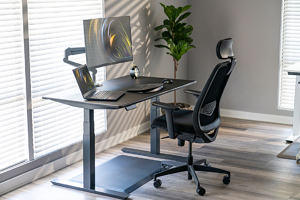

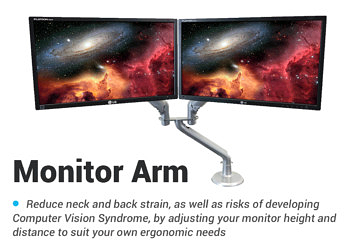
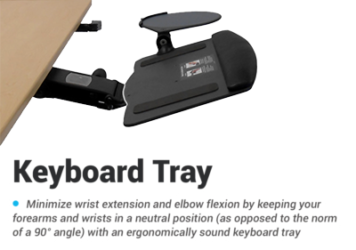
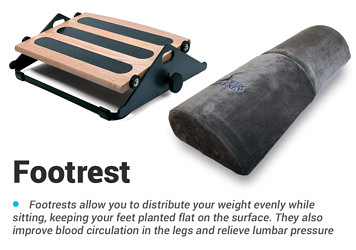
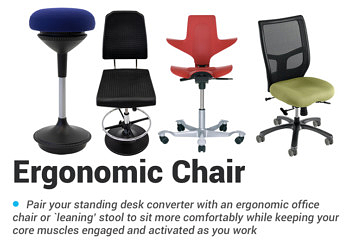
0 Comments
Leave a response >